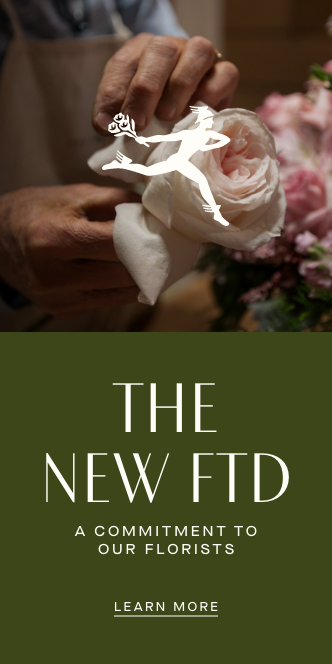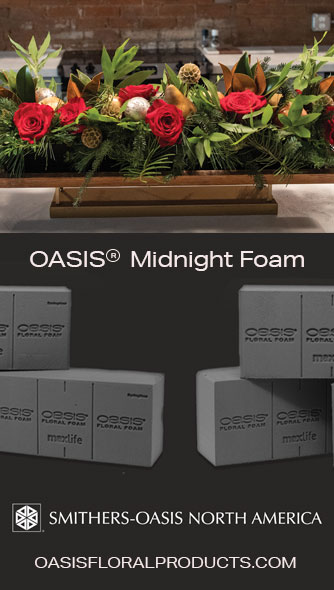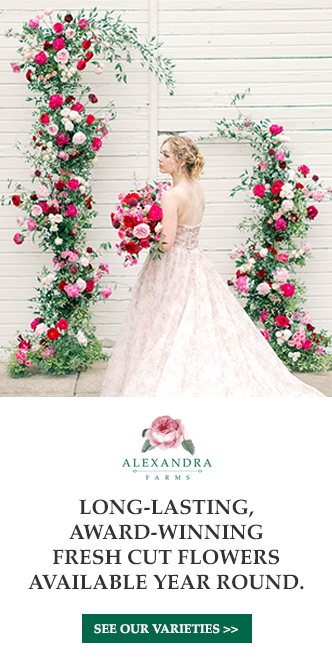Floral design and text by Julia Prokhorova, AIFD, CFD, TMF | Wild Veggie Bouquet | Corpus Christi, Texas
Photos by Cora Johnson | Cora Johnson Photography | Corpus Christi, Texas
There are so many reasons to wear a dramatic flower crown. I’ve been creating headpieces for editorials and clients for more than a decade. They’ve evolved significantly since my very first one. The biggest change? They’re now lightweight and comfortable, while maintaining an overflowing, theatrical look. I never use floral foam in headpieces, and I always minimize weight wherever possible. Big flower crowns are heavy! So, let’s make a customer-friendly headpiece that’s easy to wear.
Adding local, seasonal plants gives your headpiece a unique character. Right now, it’s cattail season where I live. The long leaves are surprisingly versatile—easy to fold, and when brushed against a metal pin frog, they separate into delicate, thread-like strands in multiple shades of green.
For this design, I created a regional fall palette with analogous hues of green, yellow and orange. The palette was brought to life by some gorgeous new varieties of garden roses from Rio Roses, which I had the pleasure of working with. The rich, textural composition captures the warmth and vibrancy of our South Texas autumn.
Every flower crown needs to be adjusted on a model—the size and diameter are easily reshaped by tweaking the wire base. When completing your design, always consider negative space to add flair. I folded a few cattail leaves and wove them through the headpiece to create depth and dimension. The result: a dramatic, feather-light, nature-inspired crown. Perfect for editorial shoots, bold styling—and yes, even a Halloween party.
STEP BY STEP


Step 1
Lay a piece of chicken wire flat on a table. To protect the model’s skin, line the bottom of the wire with a few strips of soft material. I chose kinetic bandage; felt would work, too. Next, with liquid floral adhesive or dashes, glue a layer of green leaves to cover approximately 70 percent of the bandaged portion of the mechanic. (While I chose Ficus Benjamina, lemon leaf would be an easy-to-source substitute foliage.) Then, curve the ends of your base towards each other.
Design Tip: A common mistake I see students make is trying to build the headpiece directly into a rounded shape. Whether you’re working with chicken wire or standard wire, it’s much easier to start flat.



Step 2
To create lightweight, textural elements, cut several pieces of cardboard. (I recycled vase packaging.) Brush cattail leaves with a metal pin frog, so they separate into thread-like strands. Next, wrap brushed cattail leaves around your cardboard pieces like spools; secure the ends with tape. These spools are great for creating patterns, layering and reducing the overall weight of the crown because they can cover a lot of space. Glue them to your base with liquid floral adhesive or dashes in a pattern of your choosing.


Step 3
To prepare the flowers, cut the garden rose heads from their stems. Add a drop of liquid floral adhesive to each blossom to seal in moisture. Cut several pieces of 18-gauge floral wire—two per rose, plus more for the other botanicals. Set aside a couple roses to deconstruct later in the design process. For the remaining roses repeat this process: Bend a single wire into a “U” shape. Insert the two wire ends through the center of each bloom, and then push the wire ends out on either side of the flower’s calyx. Pull gently until the curved top of the wire disappears into the center of the bloom. Add a second wire to create an “X” for extra support. Apply a finishing spray to all the roses to help the petals last longer.
Design Tip: Process and condition your roses at least 24 hours ahead of time, so they hydrate and open fully before designing.

Step 4
To the headpiece base, add medium-sized green Anthuriums—three grouped near the bottom, two slightly above—by slipping their stems into the mechanic and securing with gauge wire. Tie and twist the wires on the backside, and curl or tuck in any sharp ends.

Step 5
One rose at a time, reshape its wires “bobby-pin” style. Then securely place them onto the headpiece. Tie and twist the wires on the backside, and tuck in any sharp ends. If possible, group rose heads to create a soft gradient of color.
Design Tip: For especially thirsty blooms, insert small water tubes into the chicken wire base.

Step 6
Add a stem of yellow Gladiolus for visual balance.



Step 7
Incorporate seasonal accents like Eryngium, Eucalyptus, dried Hydrangeas, and, of course, brushed cattail leaves. Deconstruct a couple of roses and tuck the petals into the design for added interest.

Step 8
Once your chicken wire mechanic is well-covered, gently twist the ends together to fasten your headpiece in a circular shape. Inspect it from all angles and fill in any gaps.
Design Tip: I added hanging ‘Spider’ Amaranthus—it drapes beautifully and gives a lush finish. I also added Spanish moss, a few folded cattail leaves and spiky Eryngium heads for extra depth and drama.

Materials
BOTANICALS
Rosa spp. ‘Champagner’ (Rio Roses garden rose)
Rosa spp. ‘Antonia’ (Rio Roses garden rose)
Rosa spp. ‘Fancy Dreams’ (Rio Roses garden rose)
Rosa spp. ‘Tropic Versilia’ (Rio Roses garden rose)
Rosa spp. ‘Exotix Mint’ (Rio Roses garden rose)
Typha latifolia (cattail, bulrush)
Ficus benjamina (weeping fig, Benjamin fig) or Gaulteria shallon (salal, lemon leaf), foraged
Anthurium andraeanum ‘Midori’ (flamingo lily, tailflower, painter’s palette)
Eryngium spp. (sea holly, eryngo)
Eucalyptus cinerea (silver-dollar tree, argyle apple, mealy stringybark)
Gladiolus spp. (sword lily, corn flag)
Dried antique Hydrangea pieces
Amaranthus caudatus ‘Spider’ (love-lies-bleeding, tassel flower, foxtail amaranth)
Tillandsia usneoides (Spanish moss, graybeard)
HARD GOODS
OASIS™ Florist Netting
Pin frog
OASIS® Waterproof Tape
OASIS™ Florist Wire (18 gauge)
OASIS® Floral Adhesive or OASIS® UGLU™ Adhesive Dashes
FloraLife® Clear Crowning Glory®
Mueller Athletic Tape (or kinetic/sports tape)
Cardboard pieces























